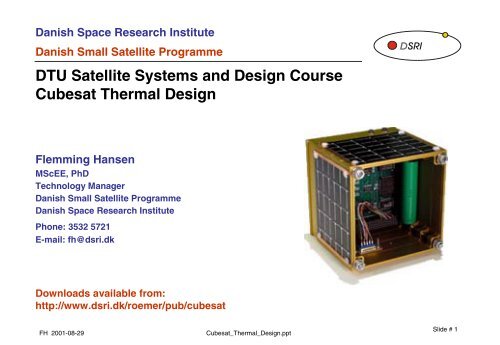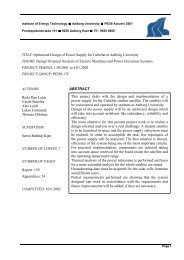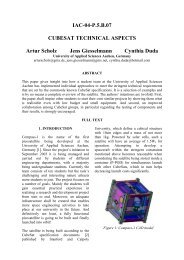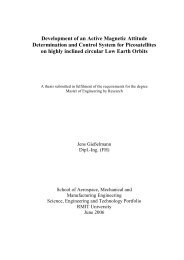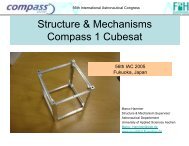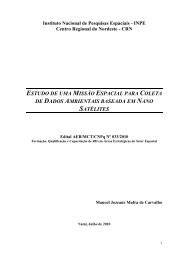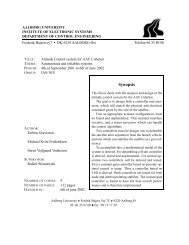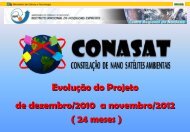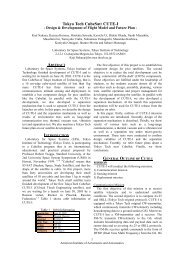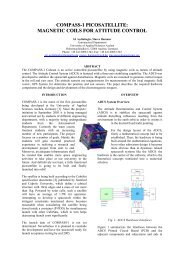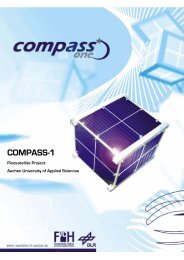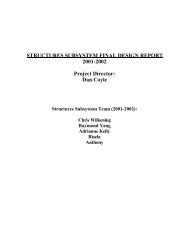DTU Satellite Systems and Design Course Cubesat Thermal ... - CRN
DTU Satellite Systems and Design Course Cubesat Thermal ... - CRN
DTU Satellite Systems and Design Course Cubesat Thermal ... - CRN
- No tags were found...
Create successful ePaper yourself
Turn your PDF publications into a flip-book with our unique Google optimized e-Paper software.
Danish Space Research Institute<br />
Danish Small <strong>Satellite</strong> Programme<br />
<strong>DTU</strong> <strong>Satellite</strong> <strong>Systems</strong> <strong>and</strong> <strong>Design</strong> <strong>Course</strong><br />
<strong>Cubesat</strong> <strong>Thermal</strong> <strong>Design</strong><br />
Flemming Hansen<br />
MScEE, PhD<br />
Technology Manager<br />
Danish Small <strong>Satellite</strong> Programme<br />
Danish Space Research Institute<br />
Phone: 3532 5721<br />
E-mail: fh@dsri.dk<br />
Downloads available from:<br />
http://www.dsri.dk/roemer/pub/cubesat<br />
FH 2001-08-29<br />
<strong>Cubesat</strong>_<strong>Thermal</strong>_<strong>Design</strong>.ppt<br />
Slide # 1
Danish Space Research Institute<br />
Danish Small <strong>Satellite</strong> Programme<br />
<strong>Thermal</strong> <strong>Design</strong><br />
• A satellite alone in the universe is a small world where conditions for “life” shall be maintained<br />
in the sense that electronics, batteries, solar cells etc. must not “die” before the mission is<br />
fulfilled.<br />
• This requires that the temperature be within certain limits.<br />
• The laws of nature will inevitably take care that an equilibrium is attained between the incident<br />
radiation from the sun, albedo from the Earth or some other body neraby <strong>and</strong> the infrared<br />
radiation to cold space.<br />
• This is exactly the same as happens for the Earth on its position in the solar system<br />
• Fortunately for us, the equilibrium here at Earth allows intelligent life.<br />
• The discipline of obtaining a satisfactory thermal balance is called thermal design<br />
FH 2001-08-29<br />
<strong>Cubesat</strong>_<strong>Thermal</strong>_<strong>Design</strong>.ppt<br />
Slide # 2
Danish Space Research Institute<br />
Danish Small <strong>Satellite</strong> Programme<br />
<strong>Thermal</strong> Transport Mechanisms<br />
There are three mechanisms for transporting heat from one point to another<br />
1. Conduction<br />
Metals are good conductors<br />
Plastics are poor conductors = good insulators<br />
2. Radiation<br />
Black surfaces are good absorbers of radiation <strong>and</strong> good radiators (emitters) of heat to space<br />
Polished metal surfaces are poor radiators <strong>and</strong> absorbers<br />
We shall see later that the heat power radiated per unit surface is proportional to T 4 ,<br />
where T is the absolute temperature of the surface<br />
3. Convection (Heat flow in a fluid or gas).<br />
This is not relevant in space except in liquid propulsion systems <strong>and</strong><br />
special devices like heat pipes<br />
FH 2001-08-29<br />
<strong>Cubesat</strong>_<strong>Thermal</strong>_<strong>Design</strong>.ppt<br />
Slide # 3
Danish Space Research Institute<br />
Danish Small <strong>Satellite</strong> Programme<br />
<strong>Thermal</strong> Environment - 1<br />
FH 2001-08-29<br />
<strong>Cubesat</strong>_<strong>Thermal</strong>_<strong>Design</strong>.ppt<br />
Slide # 4
Danish Space Research Institute<br />
Danish Small <strong>Satellite</strong> Programme<br />
<strong>Thermal</strong> Environment - 2<br />
Spectrum of Solar Radiation<br />
Emittance Spectrum of Room Temperature Body<br />
Visible light: ≈0.4 µm - ≈0.76 µm (400 - 760 nm)<br />
FH 2001-08-29<br />
<strong>Cubesat</strong>_<strong>Thermal</strong>_<strong>Design</strong>.ppt<br />
Slide # 5
Danish Space Research Institute<br />
Danish Small <strong>Satellite</strong> Programme<br />
<strong>Thermal</strong> Characteristics of Materials - 1<br />
What happens to Incident Solar Radiation <br />
In addition we need to consider the cosine law:<br />
We need to consider four effects:<br />
• Some of the power is reflected back into space (ρ)<br />
• Some of the power is absorbed <strong>and</strong> heat the surface (α)<br />
• Some of the power is transmitted into the body (τ)<br />
• When the surface is warmer than absolute zero it emits<br />
long wavelength infrared radiation with an efficiency ε<br />
(emissivity) compared to a black body (0 ≤ ε ≤ 1)<br />
Q a = S 0 ⋅α⋅A ⋅ cos(θ) , where:<br />
P a is the absorbed power<br />
S 0 is the solar constant: 1367 W/m 2<br />
α is the absorbtivity<br />
A is the area of the surface<br />
θ is the angle of incidence, i.e. the angle between the<br />
surface normal <strong>and</strong> the direction to the sun<br />
FH 2001-08-29<br />
<strong>Cubesat</strong>_<strong>Thermal</strong>_<strong>Design</strong>.ppt<br />
Slide # 6
Danish Space Research Institute<br />
Danish Small <strong>Satellite</strong> Programme<br />
<strong>Thermal</strong> Characteristics of Materials - 2<br />
How are the thermal characteristics in long wave IR<br />
compared to visible light <br />
- or - how would surfaces look like if out eyes were<br />
tuned to the 10 - 20 µm range <br />
First we should note that a surface emits long wave IR<br />
with an efficiency ε (emissivity) compared to a black<br />
body also absorbs radiation in the same wavelength<br />
range with an efficiency ε<br />
This is important when we consider radiative heat<br />
exchange within the spacecraft body or within e.g.<br />
electronics compartnments.<br />
Investigating the graph at right we realize that<br />
white = black, i.e. a paint that looks white to our eyes is<br />
actually black (almost) with long wavelength IR eyes.<br />
FH 2001-08-29<br />
<strong>Cubesat</strong>_<strong>Thermal</strong>_<strong>Design</strong>.ppt<br />
Slide # 7
Danish Space Research Institute<br />
Danish Small <strong>Satellite</strong> Programme<br />
<strong>Thermal</strong> Characteristics of Materials - 3<br />
The combined absorbtivity/emissivity properties of a<br />
surface determines its characteristics:<br />
• If the α/ε ratio is high, the surface is “warm” as it is<br />
a good absorber but a poor radiator<br />
e.g. polished aluminium or gold<br />
• If the α/ε ratio is low, the surface is “cold” as it is a<br />
poor absorber but a good radiator<br />
e.g. silvered or aluminized teflon<br />
FH 2001-08-29<br />
<strong>Cubesat</strong>_<strong>Thermal</strong>_<strong>Design</strong>.ppt<br />
Slide # 8
Danish Space Research Institute<br />
Danish Small <strong>Satellite</strong> Programme<br />
<strong>Thermal</strong> Characteristics of Materials - 4<br />
Material Absorbtivity α Emissivity ε α/ε<br />
Aluminium (6061-T6 alloy) as supplied 0.379 0.0346 10.95<br />
Aluminium (6061-T6 alloy) polished 0.2 0.031 6.45<br />
Aluminium with Alodine 1200S<br />
Chromate Conversion Coating 0.08 0.15 0.53<br />
Gold 0.299 0.023 13.00<br />
White epoxy paint 0.248 0.924 0.27<br />
Black paint 0.975 0.874 1.12<br />
Silver coated Teflon 0.08 0.66 0.12<br />
Aluminized Teflon (front surface) 0.163 0.80 0.20<br />
Aluminized 25 µm Kapton (back surface) 0.36 0.61 0.59<br />
Multi-Layer Insulation with aluminized<br />
25 µm Kapton cover sheet, large areas<br />
without seams 0.36 e* = 0.002 180<br />
Silicon solar cells (with cover glass) 0.75 0.83 0.90<br />
Gallium-Arsenide solar cells<br />
(with cover glass) 0.75 0.83 0.90<br />
FH 2001-08-29<br />
<strong>Cubesat</strong>_<strong>Thermal</strong>_<strong>Design</strong>.ppt<br />
Slide # 9
Danish Space Research Institute<br />
Danish Small <strong>Satellite</strong> Programme<br />
Radiation into Cold Space<br />
The infrared radiation in Watts into cold space from a surface (radiator) having the area A r , the<br />
absolute temperature T r <strong>and</strong> the emissivity ε is given by:<br />
Q e = ε⋅σ⋅A r ⋅(T r4 -T 04 )<br />
where σ = 5.6696⋅10 -8 W⋅m -2 ⋅K -4 is the Stephan-Boltzmann constant<br />
<strong>and</strong> T 0<br />
is the temperature of the cosmic background radiation, which closely matches the spectral<br />
properties of black-body radiation from a 2.7 K warm body. As the temperature is to the fourth<br />
power, a very good approximation is:<br />
Q e<br />
= ε⋅σ⋅A r<br />
⋅T<br />
4<br />
r<br />
FH 2001-08-29<br />
<strong>Cubesat</strong>_<strong>Thermal</strong>_<strong>Design</strong>.ppt<br />
Slide # 10
Danish Space Research Institute<br />
Danish Small <strong>Satellite</strong> Programme<br />
Temperature Equilibrium<br />
An equilibrium will always be reached some time after the solar irradiation has begun. Assuming<br />
normal incidence (ϕ = 0) <strong>and</strong> a perfectly insulated back side, temperature will adjust until Q e<br />
= Q a<br />
.<br />
This yields:<br />
ε⋅σ⋅A r<br />
⋅T r4<br />
= α⋅S 0<br />
⋅A r<br />
<strong>and</strong><br />
⎛<br />
α ⋅S 0<br />
T eq := ⎜<br />
σ⋅ε<br />
⎝<br />
1<br />
4<br />
⎞<br />
⎟<br />
⎠<br />
This is the background for the equilibrium temperatues shown ín the materials properties table <strong>and</strong><br />
the reason for the importance of the α/ε ratio<br />
FH 2001-08-29<br />
<strong>Cubesat</strong>_<strong>Thermal</strong>_<strong>Design</strong>.ppt<br />
Slide # 11
Danish Space Research Institute<br />
Danish Small <strong>Satellite</strong> Programme<br />
Problem # 1 - Temperature Equilibrium<br />
Imagine our <strong>Cubesat</strong> made from Alodine 1200S coated aluminium: α = 0.08, ε = 0.15<br />
8 GaAs solar cells 2 x 4 cm with cover glas on each of the 6 faces of the cube:<br />
α = 0.75, ε = 0.83, η = 0.25 (solar energy to electricity conversion efficiency)<br />
The <strong>Cubesat</strong> is alone in the solar system far from the Earth.<br />
The <strong>Cubesat</strong> is illuminated by the Sun at 1 AU distance with a flux of: S 0 = 1367 W/m 2<br />
The direction to the sun is parallel to the line between opposite corners of the cube.<br />
1. Calculate the incidence angle of sunlight on the three sunlit faces<br />
2. Calculate the electrical output from the solar cells<br />
3. Calculate the equilibrium temperature of the <strong>Cubesat</strong><br />
Temperature equilibrium<br />
Absorbed power:<br />
Emitted power:<br />
Q a = S 0 ⋅α⋅A ⋅ cos(θ)<br />
Q e = ε⋅σ⋅A r ⋅T 4 r (approx.)<br />
Stephan-Boltzmann constant:<br />
σ = 5.6696⋅10 -8 W⋅m -2 ⋅K -4<br />
Equilibrium condition: Q a = Q a<br />
FH 2001-08-29<br />
<strong>Cubesat</strong>_<strong>Thermal</strong>_<strong>Design</strong>.ppt<br />
Slide # 12
Danish Space Research Institute<br />
Danish Small <strong>Satellite</strong> Programme<br />
Problem # 1 - Solution<br />
1. The angle between a cube face <strong>and</strong> the farthest corner is calculated by:<br />
θ = arctan(1/√2) = 35.26°. The incidence angle is then: θ = 90° - 35.26° = 54.74°<br />
2. Three faces are illuminated at the same incidence angle: θ = 54.74°<br />
There are 64 cm 2 of solar cell area on each of three faces: A = 192 cm 2 = 0.0192 m 2<br />
Output power: P o = S 0·A·η·cos(θ) = 1367·0.0192·0.25·0.5774 = 3.79 W<br />
3. The weighted average absorbtivity of a surface is: α’ = (36·0.08+64·0.75)/100 = 0.5088<br />
The weighted average emissivity of a surface is: ε’ = (36·0.15+64·0.83)/100 = 0.5312<br />
The absorbed power on three sunlit faces is:<br />
Q a = S 0 ⋅α’⋅A⋅cos(θ) = 1367·0.5088·0.03·0.5774 = 12.048 W<br />
The radiated power comes from all six faces of the cube:<br />
Q e = ε’⋅σ⋅<br />
⋅σ⋅2A⋅T 4 r = Q a , for equilibrium<br />
Solving for T yields: T = 285.8 K = 12.6 °C<br />
FH 2001-08-29<br />
<strong>Cubesat</strong>_<strong>Thermal</strong>_<strong>Design</strong>.ppt<br />
Slide # 13
2 - 35 layers, typically around 10<br />
Danish Space Research Institute<br />
Danish Small <strong>Satellite</strong> Programme<br />
Heat Insulation - 1<br />
Often heat insulation is needed e.g. to keep an instrument sufficiently warm or the prevent heat<br />
from body-mounted solar panels from propagating into the spacecraft or for other reasons.<br />
The material of choice is MLI (Multilayer Insulation)<br />
Kapton film (Outer cover)<br />
Dacron web ("Bridal veil")<br />
Mylar film<br />
Deposited aluminium<br />
FH 2001-08-29<br />
<strong>Cubesat</strong>_<strong>Thermal</strong>_<strong>Design</strong>.ppt<br />
Slide # 14
Danish Space Research Institute<br />
Danish Small <strong>Satellite</strong> Programme<br />
Heat Insulation - 2<br />
MLI is most easily characterized by an<br />
effective emissivity: ε eff<br />
ε eff vs. Number of Layers<br />
ε eff vs. Ambient Pressure<br />
FH 2001-08-29<br />
<strong>Cubesat</strong>_<strong>Thermal</strong>_<strong>Design</strong>.ppt<br />
Slide # 15
Danish Space Research Institute<br />
Danish Small <strong>Satellite</strong> Programme<br />
Heat Insulation - 3<br />
… but the efficiency of MLI is strongly<br />
dependent on the density of<br />
discontinuities created when sewing,<br />
welding, glueing or otherwize preparing<br />
the insulating blankets<br />
Good insulation is easier to obtain on a<br />
large cryogenic fuel tank than a small<br />
scientific instrument with a complex<br />
shape<br />
FH 2001-08-29<br />
<strong>Cubesat</strong>_<strong>Thermal</strong>_<strong>Design</strong>.ppt<br />
Slide # 16
Danish Space Research Institute<br />
Danish Small <strong>Satellite</strong> Programme<br />
Heat Pipes<br />
Heat Pipes are simple <strong>and</strong> very efficient devices for transporting heat<br />
Heat Pipes are passive <strong>and</strong> may be used both at cryogenic temperature, room temperature <strong>and</strong><br />
elevated temperature depending on the working fluid selected<br />
FH 2001-08-29<br />
<strong>Cubesat</strong>_<strong>Thermal</strong>_<strong>Design</strong>.ppt<br />
Slide # 17
Danish Space Research Institute<br />
Danish Small <strong>Satellite</strong> Programme<br />
Example of Passive Cooling System for Cryo-Sensor<br />
The cold stage rejects 5 W heat at 70 K<br />
from a ≈1 m 2 surface<br />
FH 2001-08-29<br />
<strong>Cubesat</strong>_<strong>Thermal</strong>_<strong>Design</strong>.ppt<br />
Slide # 18
Danish Space Research Institute<br />
Danish Small <strong>Satellite</strong> Programme<br />
Structure<br />
• The structure shall be strong <strong>and</strong> stiff in<br />
order to withst<strong>and</strong> the vibrations, quasistatic<br />
accelarations, shock <strong>and</strong> acoustic<br />
noise during launch<br />
• The structure shall be thermally stable in<br />
order to withst<strong>and</strong> the temperature<br />
variations in orbit while maintaining<br />
instruments aligned<br />
• The structure shall provide a common<br />
electrical grounding point<br />
• The structure shall be lightweight<br />
• The structure shall be designed for easy<br />
access to equipment <strong>and</strong> <strong>and</strong> for safe <strong>and</strong><br />
easy h<strong>and</strong>ling during integration <strong>and</strong><br />
transportation<br />
Ariane 4 quasi-static acceleration<br />
profile during launch<br />
FH 2001-08-29<br />
<strong>Cubesat</strong>_<strong>Thermal</strong>_<strong>Design</strong>.ppt<br />
Slide # 19
Danish Space Research Institute<br />
Danish Small <strong>Satellite</strong> Programme<br />
Types of Structure - 1<br />
Trusses <strong>and</strong> Frames<br />
Skin-Frame Structures<br />
FH 2001-08-29<br />
<strong>Cubesat</strong>_<strong>Thermal</strong>_<strong>Design</strong>.ppt<br />
Slide # 20
Danish Space Research Institute<br />
Danish Small <strong>Satellite</strong> Programme<br />
Types of Structure - 2<br />
Monocoque Cylinder<br />
Other Cylinder<br />
Structures<br />
FH 2001-08-29<br />
<strong>Cubesat</strong>_<strong>Thermal</strong>_<strong>Design</strong>.ppt<br />
Slide # 21
Danish Space Research Institute<br />
Danish Small <strong>Satellite</strong> Programme<br />
RØMER - Trusses <strong>and</strong> Frames Structure with Shear Panels<br />
Equipment Decks<br />
Shear Panels<br />
FH 2001-08-29<br />
<strong>Cubesat</strong>_<strong>Thermal</strong>_<strong>Design</strong>.ppt<br />
Slide # 22
Danish Space Research Institute<br />
Danish Small <strong>Satellite</strong> Programme<br />
Honeycomb <strong>and</strong> Isogrid Panels<br />
FH 2001-08-29<br />
<strong>Cubesat</strong>_<strong>Thermal</strong>_<strong>Design</strong>.ppt<br />
Slide # 23
Danish Space Research Institute<br />
Danish Small <strong>Satellite</strong> Programme<br />
<strong>Cubesat</strong> Stackable Frame Structure<br />
FH 2001-08-29<br />
<strong>Cubesat</strong>_<strong>Thermal</strong>_<strong>Design</strong>.ppt<br />
Slide # 24
Danish Space Research Institute<br />
Danish Small <strong>Satellite</strong> Programme<br />
DNEPR Mission Profile for Launching Clusters of Small Spacecraft<br />
FH 2001-08-29<br />
<strong>Cubesat</strong>_<strong>Thermal</strong>_<strong>Design</strong>.ppt<br />
Slide # 25
Danish Space Research Institute<br />
Danish Small <strong>Satellite</strong> Programme<br />
DNEPR Quasi-Static <strong>and</strong> Dynamic Loads<br />
Load Source<br />
Spacecraft/Launch Vehicle Interface<br />
Axial g-load Lateral g-load<br />
Launch<br />
Movement inside the launch<br />
canister 2.4 ± 0.2 0.2 ± 0.3<br />
After exit from the launch<br />
canister 0.0 ± 0.5 0.8 ± 0.3<br />
First stage flight<br />
Maximum dynamic head nx = 3.1 ± 0.3 at gmax 0.35 ± 0.2<br />
Maximum axial g-load nx max = 7.0 ± 0.5 0.1 ± 0.4<br />
Second stage flight<br />
Maximum axial g-load nx max = 7.7 ± 0.5 0.1<br />
Third stage flight<br />
Maximum dynamic head<br />
nx = -0.3…-0.5<br />
FH 2001-08-29<br />
<strong>Cubesat</strong>_<strong>Thermal</strong>_<strong>Design</strong>.ppt<br />
Slide # 26
Danish Space Research Institute<br />
Danish Small <strong>Satellite</strong> Programme<br />
DNEPR R<strong>and</strong>om Vibration Spectral Density<br />
Actual vibration level<br />
experienced by <strong>Cubesat</strong>:<br />
6.28 g rms<br />
0.1<br />
0.1<br />
<strong>Cubesat</strong> qualification<br />
vibration level, 125% of<br />
actual: 7.85 g rms<br />
The RMS vibration level is<br />
obtained by integrating the<br />
vibration spectal density<br />
over the specified frequency<br />
b<strong>and</strong> <strong>and</strong> taking the square<br />
root:<br />
Vibration Level [g^2/Hz]<br />
D1<br />
D2<br />
0.01<br />
A1rms :=<br />
2000<br />
⌠<br />
⎮<br />
⌡<br />
20<br />
Duration: 90 sec.<br />
vsd ( f , 1)<br />
df<br />
0.001<br />
1 .10 3<br />
10 100 1 .10 3 1 .10 4<br />
10 f1<br />
10000<br />
Frequency [Hz]<br />
<strong>Cubesat</strong> actual level<br />
<strong>Cubesat</strong> qualification level<br />
FH 2001-08-29<br />
<strong>Cubesat</strong>_<strong>Thermal</strong>_<strong>Design</strong>.ppt<br />
Slide # 27
Danish Space Research Institute<br />
Danish Small <strong>Satellite</strong> Programme<br />
Transfer Function for Unit Response to Sine Vibration<br />
FH 2001-08-29<br />
<strong>Cubesat</strong>_<strong>Thermal</strong>_<strong>Design</strong>.ppt<br />
Slide # 28
Danish Space Research Institute<br />
Danish Small <strong>Satellite</strong> Programme<br />
DNEPR Acoustic Loads under Fairing<br />
Octave Frequency B<strong>and</strong><br />
Mean Geometric Frequency<br />
Hz<br />
Sound Pressure Level<br />
dB<br />
31.5 125<br />
63 132<br />
125 135<br />
250 134<br />
500 132<br />
1000 129<br />
2000 126<br />
4000 121<br />
8000 115<br />
Integral level of sound pressure<br />
dB 140<br />
Duration<br />
sec 35<br />
FH 2001-08-29<br />
<strong>Cubesat</strong>_<strong>Thermal</strong>_<strong>Design</strong>.ppt<br />
Slide # 29
Danish Space Research Institute<br />
Danish Small <strong>Satellite</strong> Programme<br />
DNEPR Shock Spectrum<br />
10000<br />
1 .10 4 <strong>Cubesat</strong> shock spectrum<br />
1 .10 3<br />
Shock Level [g]<br />
D1<br />
100<br />
10<br />
1<br />
1<br />
10 100 1 .10 3 1 .10 4<br />
10 f1<br />
10000<br />
Frequency [Hz]<br />
FH 2001-08-29<br />
<strong>Cubesat</strong>_<strong>Thermal</strong>_<strong>Design</strong>.ppt<br />
Slide # 30


